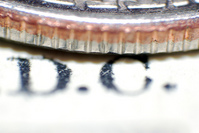How much federal money does DC actually get?

Photo by zzzack on Flickr.
Opponents of DC budget autonomy often cite Congressional funding for the city’s budget as justification of federal meddling in DC affairs. But it turns out several states rely on federal largesse even more than the District.
A Congressional appropriations subcommittee recently passed a $637 million payment to the District that includes a number of provisions detailing how the city can and cannot spend money.
That bill will now make its way to the House appropriations committee, and then to the entire House and Senate for final passage. At each stage members of Congress may offer amendments to further restrict the District’s authority in matters such as needle exchange, abortion, and gun control.
Many members of Congress believe it is their duty to micromanage the District’s local budget. Representative Darrel Issa of California, who chairs the House committee that is primarily responsible for the District, has said that Congress has an obligation to oversee how DC spends its money because “federal taxpayer dollars fund a large portion of the District’s budget.”
Many people readily agree with that statement. It seems to make sense. Of course the federal government pays for the operations of the federal district. This argument is also often cited by opponents of DC voting rights, who say that DC residents shouldn’t have a vote in Congress because they are recipients of so much federal government largesse.
Given these facts, it seems prudent to question just exactly what percentage of the District’s budget is paid using federal funds. What exactly qualifies as a “large portion”? 50%? 75%?
Not even close. Federal funds in fact make up only about 25% of the District’s local budget.
Of course, having the feds pick up the tab for one-quarter of the city government’s expenditures is nothing to sneeze at. Certainly that represents a greater percentage of the local budget than any other state government, right?
Wrong.
The US Census Bureau calculates the total federal funds transferred to state and local governments, and the total revenues collected in each state. The latest available figures (2008) reveal that Mississippi leads the nation with 35% of its combined state and local budget revenue coming from the federal government. Louisiana is a close second at 34%, followed by New Mexico and South Dakota at 27% each.
The District government receives the same percentage of federal funds as Alabama, Montana, Vermont, and West Virginia. In all, 8 states receive as much or more aid than the District. The complete list can be found below.
| State | Total state & local revenues | Federal funds | Percent |
|---|---|---|---|
| MS | 23.6 | 8.2 | 35% |
| LA | 44.2 | 15.1 | 34% |
| SD | 5.2 | 1.4 | 27% |
| NM | 16.9 | 4.5 | 27% |
| AL | 31.8 | 8.1 | 25% |
| DC | 11.8 | 3.0 | 25% |
| WV | 13.7 | 3.4 | 25% |
| MT | 8.5 | 2.1 | 25% |
| VT | 6.1 | 1.5 | 25% |
| AR | 19.6 | 4.8 | 24% |
| ME | 10.8 | 2.6 | 24% |
| KY | 29.5 | 7.0 | 24% |
| RI | 9.4 | 2.1 | 22% |
| WY | 9.4 | 2.1 | 22% |
| OK | 26.8 | 5.9 | 22% |
| MI | 68.6 | 14.9 | 22% |
| MO | 42.2 | 9.1 | 22% |
| ID | 10.5 | 2.2 | 21% |
| ND | 6.7 | 1.4 | 21% |
| OR | 29.0 | 5.9 | 20% |
| AZ | 47.7 | 9.7 | 20% |
| SC | 35.4 | 7.0 | 20% |
| NC | 77.2 | 15.1 | 20% |
| MN | 45.7 | 8.9 | 19% |
| HI | 11.9 | 2.3 | 19% |
| IA | 25.0 | 4.8 | 19% |
| GA | 73.0 | 14.0 | 19% |
| IN | 46.4 | 8.6 | 19% |
| OH | 100.9 | 18.7 | 19% |
| TN | 48.0 | 8.8 | 18% |
| NY | 243.9 | 44.7 | 18% |
| MD | 45.4 | 8.2 | 18% |
| WI | 41.7 | 7.4 | 18% |
| NH | 9.6 | 1.7 | 18% |
| PA | 109.7 | 19.0 | 17% |
| TX | 196.5 | 33.0 | 17% |
| IL | 104.2 | 17.3 | 17% |
| UT | 23.0 | 3.8 | 17% |
| KS | 22.7 | 3.7 | 16% |
| CA | 354.0 | 57.7 | 16% |
| FL | 148.0 | 23.3 | 16% |
| NE | 17.8 | 2.8 | 16% |
| DE | 8.4 | 1.3 | 15% |
| MA | 73.5 | 11.2 | 15% |
| WA | 63.2 | 9.3 | 15% |
| CT | 33.3 | 4.7 | 14% |
| VA | 58.2 | 8 | 14% |
| NJ | 85.9 | 11.5 | 13% |
| AK | 18.8 | 2.4 | 13% |
| CO | 47.1 | 5.6 | 12% |
| NV | 20.0 | 2.3 | 12% |
Clearly, multiple other states receive a larger percentage of their budget from Congress without any of the oversight that accompanies DC’s role as capital city.
Mr. Issa may ultimately be right that Congress has the authority and responsibility to exercise a higher level of oversight regarding the District, but if so it is not because of the false belief that the local government is funded to the hilt with federal dollars.
